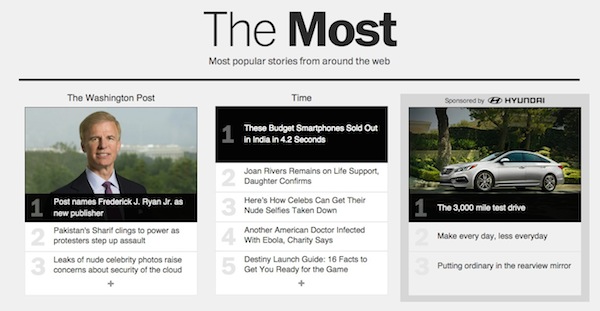Thanks in part to the recent Bezosian cash infusion, things have been busy over at The Washington Post.
In less than 6 months, the Post has launched @WaPoThing, @TheStoryline and @GetThereWP
— Noah Chestnut (@noahchestnut) August 26, 2014
Today, another new website joins the ranks of these ventures. The Post’s The Most will feature links to “most read” and “most shared” stories from around a dozen websites, including The Post’s.
On The Most, you’ll find the stories other readers are clicking on. Popular reads from The Washington Post will be there, as will trending articles from partners like Time and The Atlantic, regional news hubs like The Denver Post and The Houston Chronicle, broadcasters like New York Public Radio and digital publications like Slate and The Dodo. […]
We have agreements with newsrooms that are providing us with RSS feeds of their most popular, most read or most shared stories. Every newsroom defines these lists a little differently. Here at The Post, our “Most Read” headline lists display the stories getting the most traffic in the past two hours.
Each of the member sites displays three to five headlines in a banner at a given time. The site will be run by Katie Parker, deputy director of digital projects, who came up with the idea.

The idea of a website you can visit to see popular links that doesn’t have the static of Facebook or Twitter certainly has appeal. But it remains to be seen if there’s a significant audience for an aggregator that includes more regional content from partners like the Toledo Blade and Tampa Bay Times. But Greg Barber, digital news projects director at the Post, isn’t worried. He writes in an email:
Geography isn’t the differentiator that it used to be. As the AP has demonstrated for many years, and Reddit, Gawker and Buzzfeed have shown in recent times, stories that start out with local angles can have appeal to readers anywhere. We hope that The Most can drive discovery for readers, and that the value readers see in a single place that pulls together the web’s popular stories brings them back for more.
Other big news at the Post today — Katharine Weymouth steps down from her role as publisher. She’s been replaced by Fred J. Ryan Jr., who expressed optimism about growing news consumption and the Post’s ability to lead the charge in a newsroom address earlier today.
Ryan says local and national coverage shouldn't be mutually exclusive
— ErikWemple (@ErikWemple) September 2, 2014